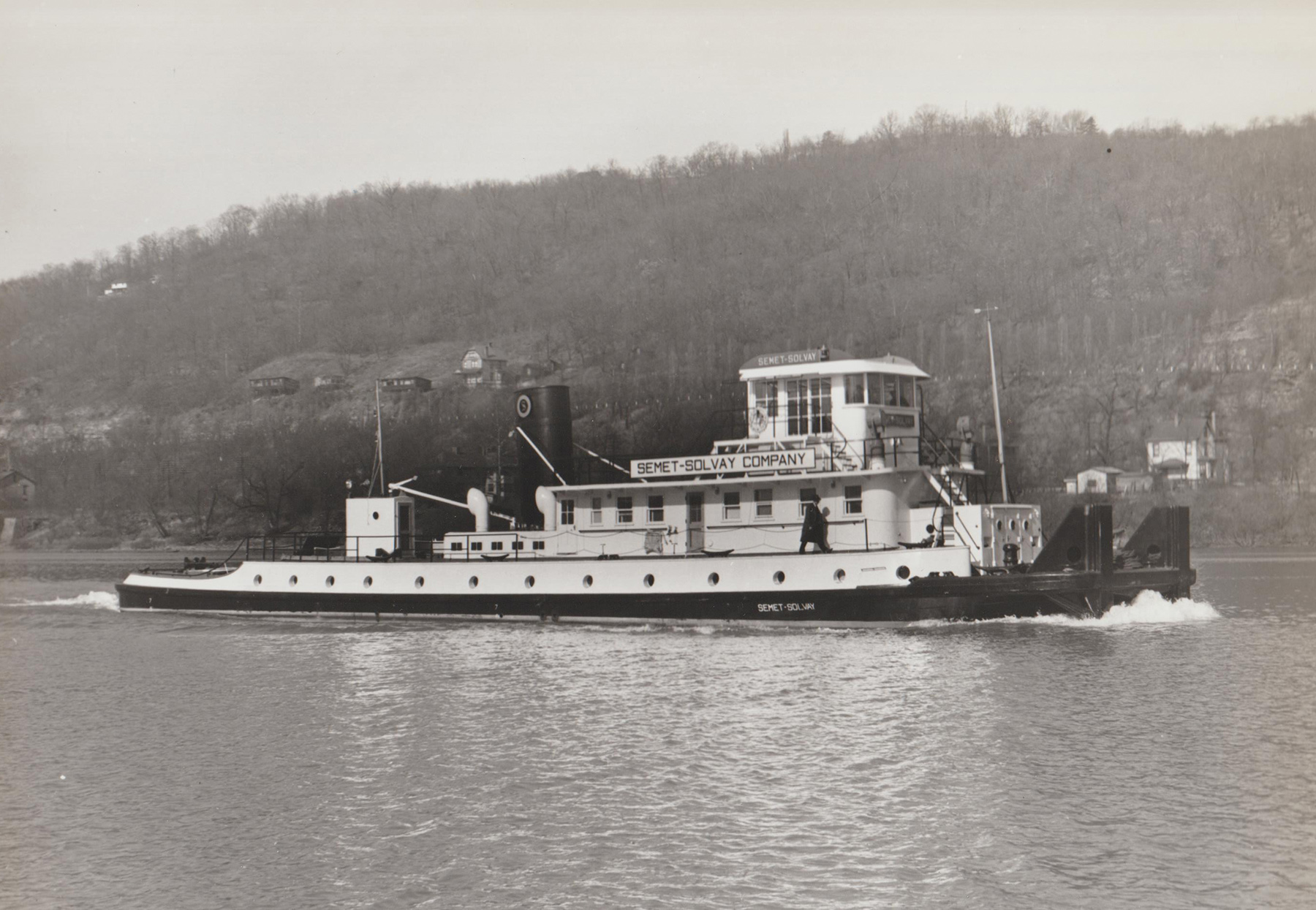In the July 29 issue of The Waterways Journal, this column detailed the Ductillite, which was the first of a series of three towboats of a radical new design that Dravo Corporation built in 1940. Since the galley and some crew quarters were located below the waterline, the vessels featured a series of portholes along the sides, just below the elevated main deck level, leading them to be called the “Dravo porthole boats.”
The Ductillite was built for Wheeling Steel and was launched on July 25, 1940. It was followed by the Victory, which hit the water on September 5, 1940, and was consigned to the Dravo subsidiary Keystone Sand. It was virtually identical to the Ductillite and would be a familiar sight in the Pittsburgh pools, towing sand and gravel until it was sold to the Argentine government in 1947 and taken to South America.
The third boat in the series was built for the Semet-Solvay Division of Allied Chemical Corporation. Semet-Solvay dated to the late 1800s when three relatives—Louis Semet and brothers Ernest and Alfred Solvay—developed an efficient oven to make coke from coal, which was then used in the iron and steelmaking process. The Semet-Solvay Company was formed in 1895, and between 1912 and 1917 a large plant was built at Ashland, Ky., on the Ohio River. In 1918, another plant was built at Ironton, Ohio, just a few miles downstream and across from Ashland.
Semet-Solvay owned its own coal mines in West Virginia, and that coal was loaded at a tipple located at Harewood, W.Va., on the Kanawha River. For several years, this coal was delivered through contract and charter carriers from Harewood to the plant at Ashland. The addition of the new Dravo-built boat in 1940 allowed the company to do much of this work itself.
The new boat was launched at the Dravo yards at Neville Island, Pa., on September 21, 1940, 84 years ago this past Saturday, and it was christened the Semet-Solvay. Like the previous two boats in the series, it had a beautifully modeled hull that was 135 feet by 27 feet. It was also powered by a pair of Cooper-Bessemer JS-6 direct reversing diesels that produced a total of 760 hp. at 310 rpm. The 66-inch propellers turned in kort nozzles, increasing the thrust to approximately 950 hp.
Unlike its predecessors, the Semet-Solvay did not have a small cabin aft of the raised pilothouse. With this exception, the cabin arrangement was the same. The engines were controlled by the engineers in the engine room, and there was a large engine order telegraph mounted on the pilothouse console by which the pilot would transmit directions to the engine room. After trials and tests utilizing the Dravo dynamometer barge in late September 1940, the new boat was delivered to the owners. The Semet-Solvay would go on to run from the Kanawha River to Ashland and Ironton for the next 30 years.
In 1946, Semet-Solvay transferred a tug/towboat named Especo from Baltimore, Md., on the east coast to Ashland. This single-screw craft, built at Orange, Texas, in 1938, performed the local harbor shifts at Ashland and Ironton, having to transit through Ohio River Lock 29 to go between the two. The following year, Hillman Barge & Construction, Brownsville, Pa., built another line boat for the firm. That vessel was named Solvay, and the Semet-Solvay had its name shortened to simply Semet. At some point the engines also had been converted to pilothouse control.
In November 1970, the coal from Kanawha River to Ashland was turned over to a contract carrier, and the larger two boats were put up for sale. Two months later, the Semet was sold to Beatty Inc., Warsaw, Ky., and renamed Clare E. Beatty. Capt. John Beatty utilized the boat to tow his extensive salvage fleet to job sites throughout the river system. The cabins were painted white with the distinctive Beatty dark yellow trim.
In January 1978, an ice gorge formed above the Markland Locks and Dam at Ohio River Mile 531. Several tows were caught in it, and the ice swept some barges into the dam. Capt. Beatty’s landing was just a short distance above the facility, and he took the Clare E. Beatty out in the attempt to help in the emergency. However, the ice was just too thick to contend with, and the boat became lodged in the heavy ice. The crew was able to evacuate to the lock wall, but the boat finally was pushed under by the pressure of ice climbing up on it.
Capt. John Beatty raised the boat after the ice dissipated and spent a year rebuilding and renovating it. In the process, the original Cooper engines were removed and replaced with a pair of Cat D398 engines of 1,800 hp. coupled to Cat 3.98:1 reduction gears. Back in service by 1981, the boat once again ushered the Beatty salvage rig from job to job.
In 1994, Capt. Beatty passed away at age 80, and the Clare E. Beatty and salvage fleet was sold to a firm that intended to use it in river salvage operations. While working on a project just below Maysville, Ky., near Ohio River Mile 409.5, a barge that was to be embedded into the bank for a dock sank. Soon after, the crane barge and both minesweeper hulls that Beatty had used to successfully raise sunken boats and barges were sunk there as well. The Clare E. Beatty sat there for a time after, with seemingly no caretaker.
At least two individuals made offers to move the boat to their respective landings to ensure that it did not sink, but their offers were denied. Then, on October 29, 1995, the boat settled to the bottom. It remains there these 29 years later, a sad, forlorn sight with no resemblance to the beauty it once was.



